Know Your Tree
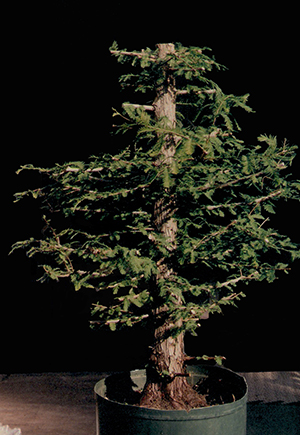
Taxodium Distichum ‘Bald Cypress’
by Lew Buller
My bald cypress is one of my favorite trees. If there were a fire and I could take only two trees, the bald cypress would be one of them. When I got it in 1995 from a friend, Brian, who had grown it in the ground for seven years in San Diego, I decided to learn as much as I could about their cultivation.
San Diego, California is a natural desert area if that tells you something about the adaptability of the bald cypress.
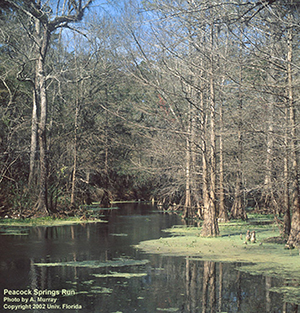
Photo by Ann Murray, University of Florida, Center for Aquatic and Invasive Plants and Used with permission
The trees in the photo to the left are identifiable as bald cypresses by their broad buttresses and the short cypress knees sticking up through the water. Mention bald cypresses to people and they will think of swamps in Louisiana, Florida, (at left) and Mississippi. They probably don’t think bald cypresses grow in cooler climes. They would be wrong.
John Naka, whose name will still ring a bell with bonsai enthusiasts, told me that Brian was a near-genius bonsai artist. Brian sold me a very good tree. It was strong and vigorous as you can tell by the foliage growing up. My job was to change the foliage from a strong vertical growth to a subdued horizontal growth. Here it is, not long after I bought it and then later after a severe trimming.
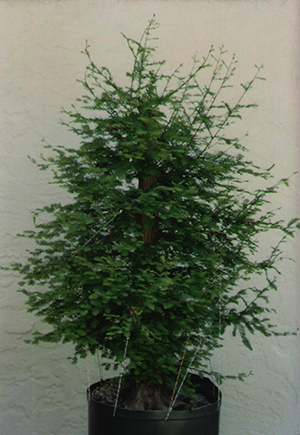

I decided to make a small model, something like a child’s model for kindergarten, and use it to record what I learned. One of the first things I needed was small bald cypresses, and I found them at Cold Stream Nursery, a wholesale shrub and bare root tree nursery in Michigan, a cold place if there ever was one http://coldstream.net. I got two 25-tree bunches of three-year old whips, planted them in muck, and let them grow for a couple of years. I was just beginning to develop branches and foliage on the big bald cypress in the form of a candle flame. Compare the two sizes of bald cypresses. While the trees were growing, I made a concrete pot and tested it to see if it would hold water.
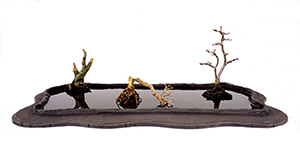
Swamps are forested wetlands containing trees and bushes, while marshes do not. Swamps start out as bodies of water that over time are filled in with trees and shrubs; the plants die, decay, and raise the level of the land, and slowly the body of water becomes a swamp. There are conifer swamps, hardwood swamps, shrub swamps (the trees are smaller), cypress swamps, and other types.
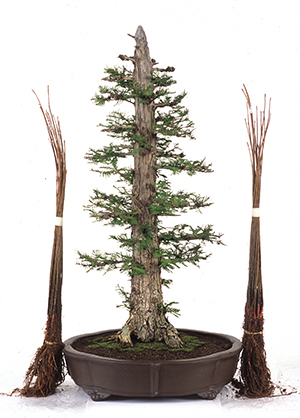
While trees in swamps need to be water tolerant, many different kinds of trees can meet this requirement. Softwood swamps have trees like loblolly pine, pitch pine, eastern white pine, eastern hemlock, northern white cedar, and black spruce, mostly coniferous. Hardwood swamps have trees like swamp white oak, black willow, red maple, pin oak, aspen, birches, cottonwood, and tupelo, mostly deciduous. Conifers (gymnosperms) produce a naked seed not enclosed in an ovary and are called softwoods; hardwoods have angiosperms that produce ovary- enclosed seeds. It is not quite correct to say that softwoods do not shed their leaves and that hardwoods are deciduous; the rule is broken by bald cypress (Taxodium distichum, a softwood), a conifer that is deciduous, hence the name “bald”.
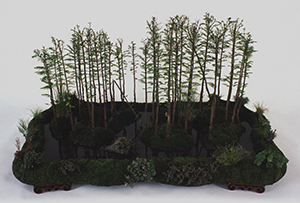
Bald cypresses may grow 24-30 inches in the first year to enable tops of the trees to be above annual flood waters, In San Diego, the trees seem to grow quicker in the ground than in water, but if grown in water, the buttresses seem to develop better.
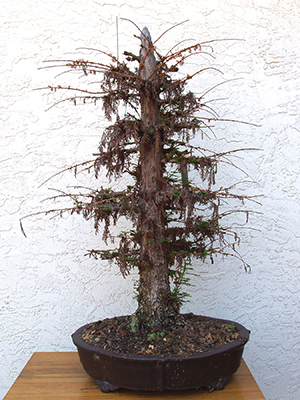
The model is no more. I took it apart, gave the trees away, and stored the pot on the floor of our garage. Unfortunately, my wife backed out one day and drove over it. No more pot. Time to concentrate on the development of my large bald cypress. When you look at the ratty photo, you will understand why I needed “development.” This was March 2008. The thin brown branches had to be cut off, any dead leaves removed, (the tree is deciduous) and the tree transplanted to fresh soil.
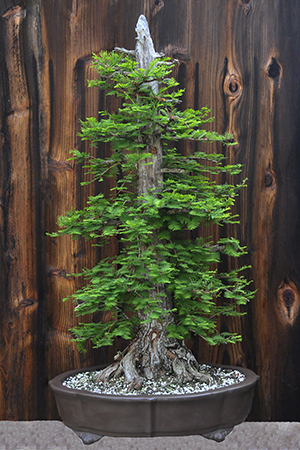
By March of 2011, the tree had begun to fill out. Now I needed only to transplant regularly and to refine its branches and outline. A word on transplanting: do not hold the tree by the barked-up trunk--hold only the dead top and the root mass when transplanting, or possibly branches that have not developed the characteristic bark pattern.
Buds growing in directions I didn’t want them to grow could be scratched off. Bald cypresses are epicormic, that is, multiple buds pop from the same location, usually around a branch cut close to the trunk. I let the multiple buds grow to build trunk size and interesting scars when they are finally removed.
San Diego water is quite alkaline–it has a pH of 8.2 or higher– and over time will leave a white deposit of salts on pots and sometimes on plants. My large bald cypress tolerates the alkalinity surprisingly well given that its natural swamp habitat is acidic as a result of rotting vegetation.
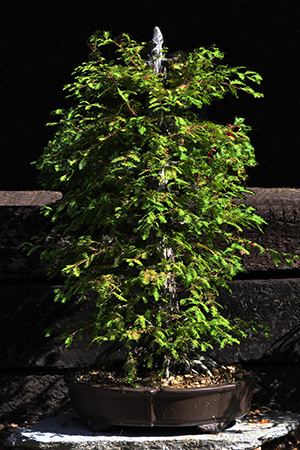
By June of 2014, the tree was again ready for a haircut. Bald cypresses are strong topgrowers. In nature, they may reach more than 100 feet tall. Here it is; a couple of techniques for trimming are also shown.
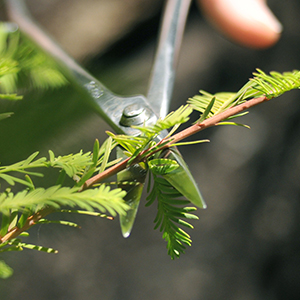
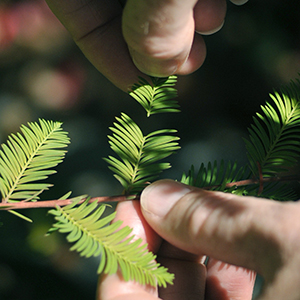
Cutting bottom branches is a no-brainer. Lacking sunlight, they will die sooner or later. The top of the branch needs to grow out a little–the design of a branch is in the shape of a cupped hand, palm down.
Pulling the tip off is a way of stopping growth, keeping the leaf small and yet leaving it with a leaflet ending. Wisteria can be treated the same way. Cutting a branch back to a downward facing leaf allows for a change in direction. Since the tree is a top grower, more work will have to be done at the top than elsewhere. As long as the top is not allowed to run wild, bottom branches will continue to grow. The deadwood at the top was no accident. Brian had sawed the top off to stop vertical growth and to encourage horizontal growth.
I don’t wire my bald cypress. While the small branches are flexible and can be wired without breaking them off, they do not set in the new position. Take the wire off and they spring right back into their former position. Neither do I fertilize them with anything except low-nitrogen fertilizers. I don’t want to stimulate growth, just keep the color a respectable green.
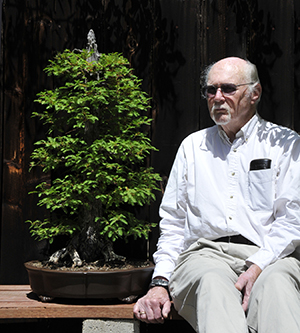
The Old Man and His Favorite Cypress, Photo by Eitan, the apprentice, June 8, 2014
There is a second type of taxodium, taxodium mucronatum (Montezuma Cypress), most easily distinguished from the distichum by its softer, downward hanging foliage. Check it out on the Internet. For those readers who do not live in a swamp, try a bald cypress anywhere south of Michigan.
